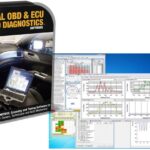Converting a vehicle from OBD1 (On-Board Diagnostics 1) to OBD2 (On-Board Diagnostics 2) is a complex undertaking that sparks frequent debate among car enthusiasts. This article delves into the feasibility, challenges, and alternatives to Converting Obd1 To Obd2, specifically focusing on a 1991 Toyota MR2 as a case study.
Understanding the OBD1 to OBD2 Conversion Challenge
The desire to convert OBD1 to OBD2 often stems from the need for enhanced diagnostics, data logging capabilities, and compatibility with modern performance tuning tools. However, the process is rarely straightforward. A direct conversion is highly unlikely due to significant differences in electronic architecture between the two systems. OBD2 utilizes a standardized digital communication protocol, while OBD1 systems vary significantly between manufacturers and even models.
Why Converting an OBD1 MR2 to OBD2 is Difficult
The 1991 Toyota MR2 in question presents specific challenges. As the last US model year for this generation (SW20) was 1995, Toyota never released an OBD2 compliant version in America. This absence of a factory OBD2 equivalent makes a direct parts swap impossible.
Even if a compatible OBD2 system existed, the conversion would necessitate replacing numerous components, including:
- ECU (Engine Control Unit): The brain of the engine management system needs to be OBD2 compatible.
- Wiring Harness: The entire wiring system connecting the ECU to sensors and actuators might require replacement.
- Sensors: OBD2 often requires additional sensors not present in OBD1 systems, such as a second oxygen sensor.
Alternatives to a Full OBD1 to OBD2 Conversion
Given the complexities of a full conversion, several alternatives offer more practical solutions for achieving desired functionalities:
-
Standalone Engine Management Systems (EMS): Systems like Megasquirt (MS) provide comprehensive engine control and data logging capabilities, often surpassing OBD2 functionality. They offer flexibility for tuning and customization.
-
Race ECUs: Designed for performance applications, race ECUs offer high-speed data logging and advanced tuning options. Several plug-and-play solutions exist for the MR2 Turbo.
-
OBD1 Data Logging Solutions: While less common, specific tools and software might exist for extracting data from the original OBD1 ECU. Exploring model-specific forums and communities can uncover such options. A custom data acquisition system using an Arduino could be built, but requires significant technical expertise.
Considering Data Logging Needs
Before pursuing any solution, clearly defining your data logging requirements is crucial. Basic OBD2 data logging, especially on pre-CAN bus systems, often suffers from low data rates, limiting its usefulness for performance analysis. If high-frequency data acquisition is essential, a standalone EMS or race ECU is a more suitable choice.
Conclusion: Choosing the Right Path for Your MR2
Converting a 1991 MR2 from OBD1 to OBD2 is a highly impractical endeavor. While theoretically possible with significant effort and expense, superior alternatives exist. For enhanced diagnostics and data logging, exploring standalone EMSs, race ECUs, or model-specific OBD1 solutions provides a more efficient and cost-effective approach. Consider your specific needs and technical capabilities when making a decision. A standalone system often offers the best balance between functionality, flexibility, and cost for performance enthusiasts.
